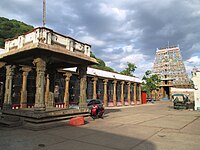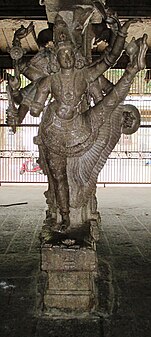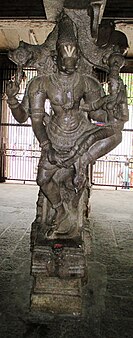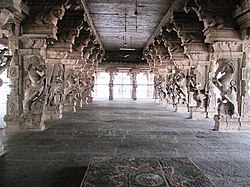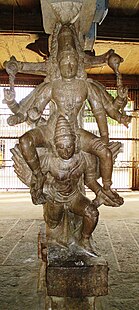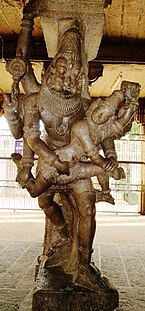
Alagar Kovil is a village in Madurai district in the South Indian state of Tamil Nadu. The history and living of the village is centered around Kallalagar Temple. Constructed in the Dravidian style of architecture, the temple is glorified in the Nalayira Divya Prabandham, the early medieval Tamil canon of the Alvar saints from the 6th–9th centuries CE. It is one of the 108 Divya Desams dedicated to Vishnu, who is worshiped as Kallalagar and his consort Lakshmi as Tirumamagal.
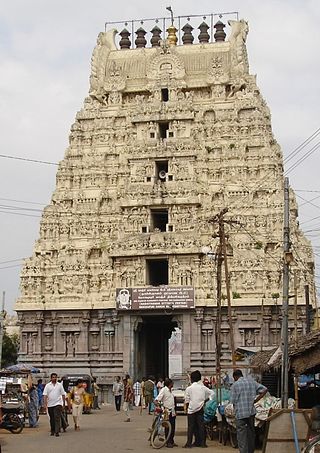
The Kamakshi Amman Temple, also known as Kamakoti Nayaki Kovil, is a Hindu temple dedicated to the goddess Kamakshi, one of the highest aspects of Adi Parashakti, the supreme goddess in Shaktism. The temple is located in the historic city of Kanchipuram, near Chennai, India.

The Srivilliputhur Andal Temple in Srivilliputhur, a town in Virudhunagar district in the South Indian state of Tamil Nadu, is dedicated to the Hindu god Vishnu. It is located 80 km from Madurai. Constructed in the Dravidian style of architecture, the temple is glorified in the Nalayira Divya Prabandham, the early medieval Tamil canon of the Alvar saints from the 6th–9th centuries CE. It is one of the 108 Divya Desams dedicated to Vishnu, who is worshipped as Vatapatrasayi and his consort Lakshmi as Andal. It is believed to be the birthplace of two of the Alvars, namely Periyalvar and his foster-daughter, Andal.

Koodal Aḻagar Temple in Madurai, a city in the South Indian state of Tamil Nadu, is dedicated to the Hindu god Vishnu. Constructed in the Dravidian style of architecture, the temple is glorified in the Naalayira Divya Prabandham, the early medieval Tamil canon of the Alvar saints from the 6th–9th centuries CE. It is one of the 108 Divya Desams dedicated to Vishnu, who is worshipped as Viyooga Sundarrajan, and his consort Lakshmi as Mathuravalli.
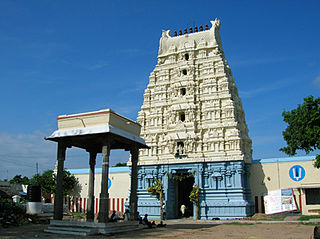
Sri Bhaktavatsala Perumal temple is a Hindu temple, located at Thirunindravur, a western suburb of Chennai, India. It is dedicated to the Hindu deity Vishnu. Constructed in the Dravidian style of architecture, the temple is glorified in the Naalayira Divya Prabandham, the early medieval Tamil canon of the Alvar saints from the 6th–9th centuries CE. It is one of the 108 Divya Desams dedicated to Vishnu, who is worshipped as Bhaktavatsala Perumal and his consort Lakshmi as Ennai Petra Thayar.
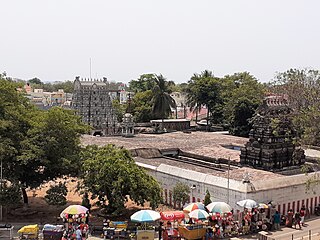
Sthalasayana Perumal Temple is at Mahabalipuram. Constructed in the Dravidian style of architecture, the temple is glorified in the Naalayira Divya Prabandham, the early medieval Tamil canon of the Alvar saints from the 6th–9th centuries CE. It is one of the 108 Divya Desam dedicated to Vishnu, who is worshipped as Sthalasayana Perumal and his consort Lakshmi as Nilamangai Thayar. The temple is believed to have been built by the Pallavas, with later contributions from the Medieval Cholas, Vijayanagara kings, and Madurai Nayaks.

Veeraraghava Swamy Temple is a temple dedicated to the Hindu god Vishnu, located in Tiruvallur, Chennai Metropolitan City, an area and headquarters in Tiruvallur district in the South Indian state of Tamil Nadu. Constructed in Dravidian style of architecture, the temple is glorified in the Divya Prabandham, the early medieval Tamil canon of the Alvar saints from the 6th–9th centuries CE. It is counted as one among the 108 Divya Desams dedicated to Vishnu. Vishnu is worshipped as Veeraraghava Perumal, and his consort Lakshmi as Kanakavalli Thayar.
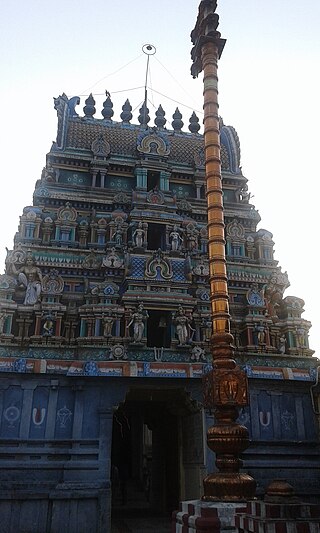
The Devaadi Raja Perumal temple in Therazhundur, a village in Mayiladuthurai district of the South Indian state of Tamil Nadu, is dedicated to the Hindu god Vishnu. Constructed in the Dravidian style of architecture, the temple is glorified in the Naalayira Divya Prabandham, the early medieval Tamil canon of the Alvar saints from the 6th–9th centuries CE. It is one of the 108 Divya Desams dedicated to Vishnu, who is worshipped as Amaruviappan, and his consort Lakshmi as Sengamalavalli Thayar. The original structure of the temple was built by the Karikala Chola during the 1st century CE, with later additions from the Cholas during the 11th century.

Thiru Anbil, or Sundararaja Perumal Temple, in Anbil, a village in the outskirts of Tiruchirappalli in the South Indian state of Tamil Nadu, is dedicated to the Hindu god Vishnu. Constructed in the Dravidian style of architecture, the temple is glorified in the Naalayira Divya Prabandham, the early medieval Tamil canon of the Alvar saints from the 6th–9th centuries CE. It is one of the 108 Divya Desams dedicated to Vishnu, who is worshipped as Sundararajan and his consort Lakshmi as Sundaravalli.
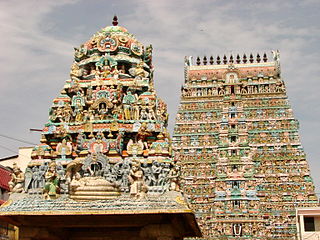
The Sarangapani Temple is a Hindu temple dedicated to Vishnu, located in Kumbakonam, Tamil Nadu, India. It is one of the Divya Desams, the 108 temples of Vishnu revered in Nalayira Divya Prabandham by the 12 poet saints, or Alvars. This temple is along Kaveri and is one of the Pancharanga Kshetrams.

The Jagad Rakshaka Perumal Temple or Thirukoodalur in Vadakurangaduthurai, a village in the outskirts of Kumbakonam in the South Indian state of Tamil Nadu, is dedicated to the Hindu god Vishnu. Constructed in the Dravidian style of architecture, the temple is glorified in the Nalayira Divya Prabandham, the early medieval Tamil canon of the Alvar saints from the 6th–9th centuries CE. It is one of the 108 Divya Desams dedicated to Vishnu, who is worshipped as Jakath Rakshaka and his consort Lakshmi as Pushpavalli.

The Meenakshi Tirukalyanam festival, also known as Chithirai Tiruviḻa or Meenakshi Kalyanam, is an annual Tamil Hindu celebration in the city of Madurai during the month of April. The festival, celebrated during the Tamil month of Chithirai, is associated with the Meenakshi Temple, dedicated to the goddess Meenakshi, a form of Parvati and her consort Sundareshvara, a form of Shiva.

Parimala Ranganathar Perumal Temples or Tiruindaloor is a Hindu temple dedicated to Vishnu, located in Thiruvilandur of Mayiladuthurai, a town in the South Indian state of Tamil Nadu. It is one of the Divya Desams, the 108 temples of Vishnu revered in Nalayira Divya Prabandham by the 12 poet saints, or the Alvars. This temple is along Kaveri and is one of the Pancharanga Kshetrams.

The Gajendra Varadha Perumal Temple in Thirukkavithalam, a village in the outskirts of Papanasam in the South Indian state of Tamil Nadu, is dedicated to the Hindu god Vishnu. Constructed in the Dravidian style of architecture, the temple is glorified in the Nalayira Divya Prabandham, the early medieval Tamil canon of the Alvar saints from the 6th–9th centuries CE. It is one of the 108 Divya Desams dedicated to Vishnu, who is worshipped as Gajendra Varadha Perumal and his consort Lakshmi as Ramamanivalli. The temple is one of the five Pancha-Kannan temples, where Krishna, an avatar of Vishnu is given prominence over the presiding deity.

Thanjai Mamani Koil is a set of three adjacent Hindu temples dedicated to Vishnu located in Thanjavur, Tamil Nadu, India. It is one of the Divya Desams, the 108 temples of Vishnu revered by the 12 poet saints called the Alvars. Unlike other Divya Desams where a single shrine is referenced, this set of temples is referred together in all the pasurams.

The Makara Nedunkuḻaikathar Temple is one of the Nava Tirupathi, nine Hindu temples dedicated to Vishnu located Thenthiruperai along Tiruchendur-Tirunelveli route, Tamil Nadu, India in the southern bank of Thamiraparani river. It is located 5 km from Alvar Thirunagari All these 9 temples are classified as Divya Desams, the 108 temples of Vishnu revered by the 12 poet saints, or Alvars. The temple is referred to as Sukra sthalam, a location for the planet deity, Sukra. Constructed in the Dravidian style of architecture, the temple is glorified in the Nalayira Divya Prabandham, the early medieval Tamil canon of the Alvar saints from the 6th–9th centuries CE. It is one of the 108 Divya Desams dedicated to Vishnu, who is worshipped as Makara Nedunkuḻaikathar and his consort Lakshmi as Tiruperai Nachiyar.
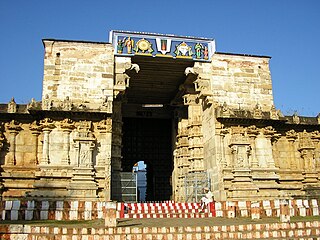
Vaishnava Nambi and Thirukurungudivalli Nachiar Temple in Thirukkurungudi, a village in Tirunelveli district in the South Indian state of Tamil Nadu, is dedicated to the Hindu god Vishnu. It is located 45 km from Tirunelveli. Constructed in the Dravidian style of architecture, the temple is glorified in the Naalayira Divya Prabandham, the early medieval Tamil canon of the Alvar saints from the 6th–9th centuries CE. It is one of the 108 Divya Desams dedicated to Vishnu, who is worshipped as Vaishnava Nambi and his consort Lakshmi as Thirukurungudivalli. The temple is locally referred as Dakshina Vaikuntam, the holy abode of Vishnu.

Tamil Nadu is known for its ancient temple architecture. Nearly 33,000 ancient temples, many at least 800 to 2000 years old, are found scattered all over Tamil Nadu. As per Tamil Nadu Hindu Endowments Board, there are 38,615 temples. Most of the largest Hindu Temples reside here. Studded with complex architecture, a variety of sculptures, and rich inscriptions, the temples remain the very essence of the culture and heritage of Tamil land, with historical records dating back to at least 3,000 years.

The Soundararajaperumal Temple is a temple dedicated to Hindu god Vishnu, located in Thadikombu, a village near Dindigul in the South Indian state of Tamil Nadu. Constructed in Dravidian style of architecture, the temple is believed to have been built by Achyuta Deva Raya during the 16th century CE. Vishnu is worshipped as Soundararaja Perumal and his consort Lakshmi as Soundaravalli.
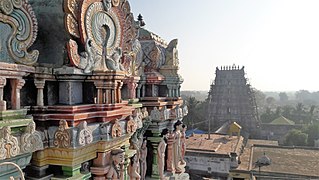
Sowmyanarayana Perumal Temple is an ancient temple located in Thirukoshtiyur, a village in the South Indian state of Tamil Nadu, dedicated to the Hindu god Vishnu. Constructed in the Dravidian style of architecture, the temple is glorified in the Nalayira Divya Prabandham, the early medieval Tamil canon of the Alvar saints from the 6th–9th centuries CE. It is one of the 108 Divya Desams dedicated to Vishnu, who is worshipped as Sowmyanarayana Perumal and his consort Lakshmi as Thirumamagal. The temple is known as the place where Ramanuja, the expounder of Vishishtadvaita philosophy preached the holy ashtakshara "Om Namo Narayanaya" to all people, irrespective of their varna.


